A full pharmacological analysis of the three turkey β-adrenoceptors and comparison with the human β-adrenoceptors
- PMID: 21152092
- PMCID: PMC2994877
- DOI: 10.1371/journal.pone.0015487
A full pharmacological analysis of the three turkey β-adrenoceptors and comparison with the human β-adrenoceptors
Abstract
Background: There are three turkey β-adrenoceptors: the original turkey β-adrenoceptor from erythrocytes (tβtrunc, for which the X-ray crystal structure has recently been determined), tβ3C and tβ4C-receptors. This study examined the similarities and differences between these avian receptors and mammalian receptors with regards to binding characteristics and functional high and low affinity agonist conformations.
Methodology/principal findings: Stable cell lines were constructed with each of the turkey β-adrenoceptors and 3H-CGP12177 whole cell binding, CRE-SPAP production and (3)H-cAMP accumulation assays performed. It was confirmed that the three turkey β-adrenoceptors are distinct from each other in terms of amino acid sequence and binding characteristics. The greatest similarity of any of the turkey β-adrenoceptors to human β-adrenoceptors is between the turkey β3C-receptor and the human β2-adrenoceptor. There are pharmacologically distinct differences between the binding of ligands for the tβtrunc and tβ4C and the human β-adrenoceptors (e.g. with CGP20712A and ICI118551). The tβtrunc and tβ4C-adrenoceptors appear to exist in at least two different agonist conformations in a similar manner to that seen at both the human and rat β1-adrenoceptor and human β3-adrenoceptors. The tβ3C-receptor, similar to the human β2-adrenoceptor, does not, at least so far, appear to exist in more than one agonist conformation.
Conclusions/significance: There are several similarities, but also several important differences, between the recently crystallised turkey β-adrenoceptor and the human β-adrenoceptors. These findings are important for those the field of drug discovery using the recently structural information from crystallised receptors to aid drug design. Furthermore, comparison of the amino-acid sequence for the turkey and human adrenoceptors may therefore shed more light on the residues involved in the existence of the secondary β-adrenoceptor conformation.
Conflict of interest statement
Figures
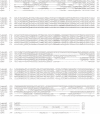
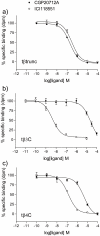

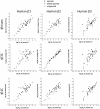
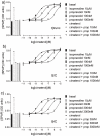
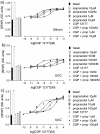
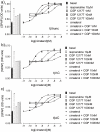
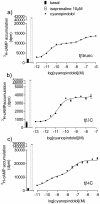
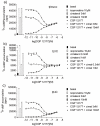
Similar articles
-
The pharmacological effects of the thermostabilising (m23) mutations and intra and extracellular (β36) deletions essential for crystallisation of the turkey β-adrenoceptor.Naunyn Schmiedebergs Arch Pharmacol. 2011 Jul;384(1):71-91. doi: 10.1007/s00210-011-0648-4. Epub 2011 May 6. Naunyn Schmiedebergs Arch Pharmacol. 2011. PMID: 21547538 Free PMC article.
-
Characterization of beta-adrenoceptors responsible for venom production in the venom gland of the snake Bothrops jararaca.Life Sci. 2000 Jun 8;67(3):217-26. doi: 10.1016/s0024-3205(00)00626-3. Life Sci. 2000. PMID: 10983865
-
Identification of key residues in transmembrane 4 responsible for the secondary, low-affinity conformation of the human β1-adrenoceptor.Mol Pharmacol. 2014 May;85(5):811-29. doi: 10.1124/mol.114.091587. Epub 2014 Mar 7. Mol Pharmacol. 2014. PMID: 24608857 Free PMC article.
-
Human heart beta-adrenoceptors: beta1-adrenoceptor diversification through 'affinity states' and polymorphism.Clin Exp Pharmacol Physiol. 2007 Oct;34(10):1020-8. doi: 10.1111/j.1440-1681.2007.04730.x. Clin Exp Pharmacol Physiol. 2007. PMID: 17714089 Review.
-
Beta 3-adrenoceptors and intestinal motility.Fundam Clin Pharmacol. 1995;9(4):332-42. doi: 10.1111/j.1472-8206.1995.tb00507.x. Fundam Clin Pharmacol. 1995. PMID: 8566932 Review.
Cited by
-
Structural basis and mechanism of activation of two different families of G proteins by the same GPCR.Nat Struct Mol Biol. 2021 Nov;28(11):936-944. doi: 10.1038/s41594-021-00679-2. Epub 2021 Nov 10. Nat Struct Mol Biol. 2021. PMID: 34759376 Free PMC article.
-
The β3 -adrenoceptor agonist mirabegron increases human atrial force through β1 -adrenoceptors: an indirect mechanism?Br J Pharmacol. 2017 Aug;174(16):2706-2715. doi: 10.1111/bph.13897. Epub 2017 Jul 7. Br J Pharmacol. 2017. PMID: 28574581 Free PMC article.
-
Pharmacological Analysis and Structure Determination of 7-Methylcyanopindolol-Bound β1-Adrenergic Receptor.Mol Pharmacol. 2015 Dec;88(6):1024-34. doi: 10.1124/mol.115.101030. Epub 2015 Sep 18. Mol Pharmacol. 2015. PMID: 26385885 Free PMC article.
-
Ligand occupancy in crystal structure of β1-adrenergic G protein-coupled receptor.Nat Struct Mol Biol. 2015 Dec;22(12):941-2. doi: 10.1038/nsmb.3130. Nat Struct Mol Biol. 2015. PMID: 26643842 Free PMC article. No abstract available.
-
The pharmacological effects of the thermostabilising (m23) mutations and intra and extracellular (β36) deletions essential for crystallisation of the turkey β-adrenoceptor.Naunyn Schmiedebergs Arch Pharmacol. 2011 Jul;384(1):71-91. doi: 10.1007/s00210-011-0648-4. Epub 2011 May 6. Naunyn Schmiedebergs Arch Pharmacol. 2011. PMID: 21547538 Free PMC article.
References
-
- Pak MD, Fishman PH. Anomalous behaviour of CGP 12177A on beta 1-adrenergic receptors. J Recept Signal Transduction Res. 1996;16:1–23. - PubMed
-
- Granneman JG. The putative beta4-adrenergic receptor is a novel state of the beta1-adrenergic receptor. Am J Physiol Endocrinol Metab. 2001;280:E199–202. - PubMed
-
- Kaumann AJ, Molenaar P. The low-affinity site of the beta1-adrenoceptor and its relevance to cardiovascular pharmacology. Pharmacol Ther. 2008;118:303–336. - PubMed
Publication types
MeSH terms
Substances
Grants and funding
LinkOut - more resources
Full Text Sources
Other Literature Sources
Molecular Biology Databases

